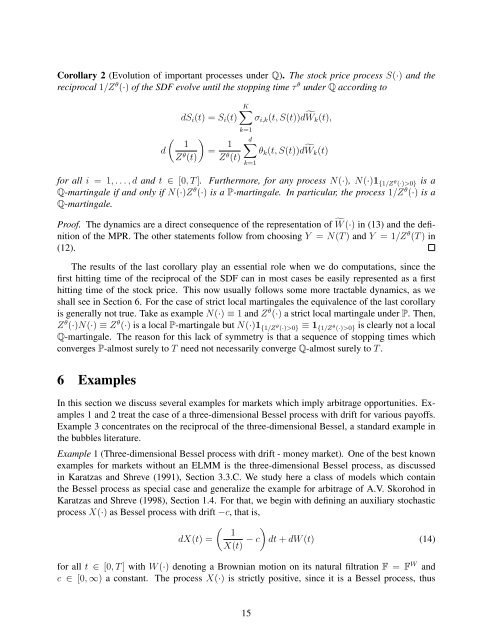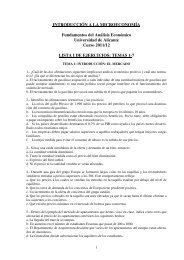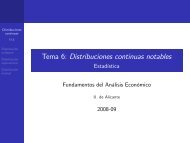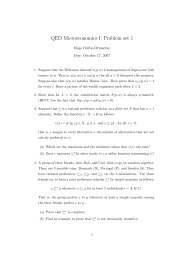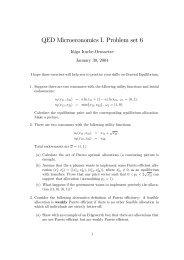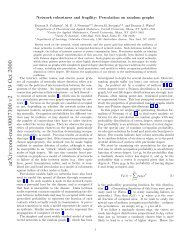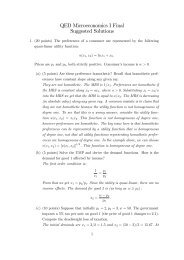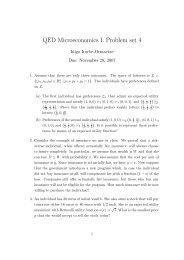Hedging under arbitrage
Hedging under arbitrage
Hedging under arbitrage
You also want an ePaper? Increase the reach of your titles
YUMPU automatically turns print PDFs into web optimized ePapers that Google loves.
Corollary 2 (Evolution of important processes <strong>under</strong> Q). The stock price process S(·) and the<br />
reciprocal 1/Z θ (·) of the SDF evolve until the stopping time τ θ <strong>under</strong> Q according to<br />
dSi(t) = Si(t)<br />
�<br />
1<br />
d<br />
Zθ �<br />
=<br />
(t)<br />
1<br />
Zθ (t)<br />
K�<br />
σi,k(t, S(t))d� Wk(t),<br />
k=1<br />
d�<br />
θk(t, S(t))d� Wk(t)<br />
k=1<br />
for all i = 1, . . . , d and t ∈ [0, T ]. Furthermore, for any process N(·), N(·)1 {1/Z θ (·)>0} is a<br />
Q-martingale if and only if N(·)Z θ (·) is a P-martingale. In particular, the process 1/Z θ (·) is a<br />
Q-martingale.<br />
Proof. The dynamics are a direct consequence of the representation of � W (·) in (13) and the definition<br />
of the MPR. The other statements follow from choosing Y = N(T ) and Y = 1/Z θ (T ) in<br />
(12).<br />
The results of the last corollary play an essential role when we do computations, since the<br />
first hitting time of the reciprocal of the SDF can in most cases be easily represented as a first<br />
hitting time of the stock price. This now usually follows some more tractable dynamics, as we<br />
shall see in Section 6. For the case of strict local martingales the equivalence of the last corollary<br />
is generally not true. Take as example N(·) ≡ 1 and Z θ (·) a strict local martingale <strong>under</strong> P. Then,<br />
Z θ (·)N(·) ≡ Z θ (·) is a local P-martingale but N(·)1 {1/Z θ (·)>0} ≡ 1 {1/Z θ (·)>0} is clearly not a local<br />
Q-martingale. The reason for this lack of symmetry is that a sequence of stopping times which<br />
converges P-almost surely to T need not necessarily converge Q-almost surely to T .<br />
6 Examples<br />
In this section we discuss several examples for markets which imply <strong>arbitrage</strong> opportunities. Examples<br />
1 and 2 treat the case of a three-dimensional Bessel process with drift for various payoffs.<br />
Example 3 concentrates on the reciprocal of the three-dimensional Bessel, a standard example in<br />
the bubbles literature.<br />
Example 1 (Three-dimensional Bessel process with drift - money market). One of the best known<br />
examples for markets without an ELMM is the three-dimensional Bessel process, as discussed<br />
in Karatzas and Shreve (1991), Section 3.3.C. We study here a class of models which contain<br />
the Bessel process as special case and generalize the example for <strong>arbitrage</strong> of A.V. Skorohod in<br />
Karatzas and Shreve (1998), Section 1.4. For that, we begin with defining an auxiliary stochastic<br />
process X(·) as Bessel process with drift −c, that is,<br />
� �<br />
1<br />
dX(t) = − c dt + dW (t) (14)<br />
X(t)<br />
for all t ∈ [0, T ] with W (·) denoting a Brownian motion on its natural filtration F = F W and<br />
c ∈ [0, ∞) a constant. The process X(·) is strictly positive, since it is a Bessel process, thus<br />
15


